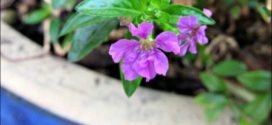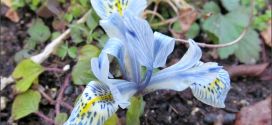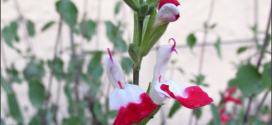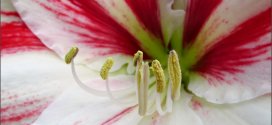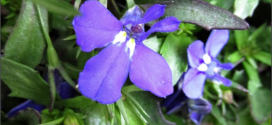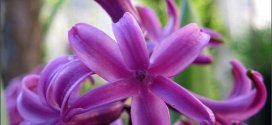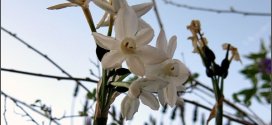Cuphea hyssopifolia, commonly called Mexican heather, is native from Mexico to Guatemala. It is a rounded, densely branched 1-2’ tall tropical sub-shrub. It produces quaint, small, trumpet-shaped flowers with six spreading lavender petals and green calyx tubes. Flowers appear singly in the leaf axils along stems crowded with lance-shaped glossy green leaves (to 3/4” long). Blooms profusely summer to frost. …
Read More »Tag Archives: perennial
Daylily
The scientific name for daylily is Hemerocallis. The word Hemerocallis is derived from two Greek words meaning “beauty” (callos) and “day” (hemera), referring to the fact that each flower lasts only one day. To make up for this, there are many flower buds on each daylily flower stalk, and many stalks in each clump of plants, so, the flowering period …
Read More »Muscari – Grape Hyacinth
Grape Hyacinth is one of the first spring flowers and has a great fragrance. The first time you plant them should be in November. The plants naturalize (meaning that the next year’s flowers are the same). Severe poisoning from hyacinth or tulip poisoning is often seen when dogs dig up freshly planted bulbs or having access to a large bag …
Read More »Pacific Coast Iris
Our native Pacific Coast irises include 11 species that produce flowers in shades of white, yellow, pink, lavender, even USC-worthy cardinal and gold. Most of the Pacific Coast irises, or Pacificas, sold in California are from a single species, Iris douglasiana. To learn about the foliage and flower distinctions behind each species classification, there is no better source than the …
Read More »Amaryllis Belladonna – Pink Lady
Belladonna Lily, Pink Lady, Naked Lady, Amaryllis belladonna. In winter, the bulbs produce many leaves. The leaves die off by March. In the hot dry days of August, thick stocks shoot up from the bare ground (hence Naked Ladies).
Read More »Salvia – Hot Lips
Autumn Sage, Salvia x jamensis ‘Hot Lips’ Family: Lamiaceae (lay-mee-AY-see-ee) (Info) Genus: Salvia (SAL-vee-uh) (Info) Species: x jamensis Cultivar: Hot Lips Synonym:Salvia microphylla Category: Tropicals and Tender Perennials Height: 36-48 in. (90-120 cm) 4-6 ft. (1.2-1.8 m) Spacing: 18-24 in. (45-60 cm) Hardiness: USDA Zone 8a: to -12.2 °C (10 °F) USDA Zone 8b: …
Read More »Amaryllis – Christmas
Amaryllis, Christmas, Hippeastrum x ? Family: Amaryllidaceae (am-uh-ril-id-AY-see-ee) (Info) Genus: Hippeastrum (hip-ee-ASS-trum) (Info) Species: x ? Category: Bulbs Height: 18-24 in. (45-60 cm) Spacing: 6-9 in. (15-22 cm) Hardiness: USDA Zone 6a: to -23.3 °C (-10 °F) USDA Zone 6b: to -20.5 °C (-5 °F) USDA Zone 7a: to -17.7 °C (0 °F) USDA Zone …
Read More »Lobelia
Blue Lobelia, Lobelia siphilitica Family: Campanulaceae (kam-pan-yew-LAY-see-ee) (Info) Genus: Lobelia (low-BEE-lee-a) (Info) Species: siphilitica (sigh-fy-LY-tih-kuh) (Info) Category: Perennials Height: 24-36 in. (60-90 cm) Spacing: 18-24 in. (45-60 cm) Hardiness: USDA Zone 4a: to -34.4 °C (-30 °F) USDA Zone 4b: to -31.6 °C (-25 °F) USDA Zone 5a: to -28.8 °C (-20 °F) USDA …
Read More »Hyacinth
Dutch Hyacinth, Hyacinthus orientalis. Attractive to bees, butterflies and/or birds. Flowers are fragrant. This plant is suitable for growing indoors. Average Water Needs; Water regularly; do not overwater. Flowers are good for cutting Severe poisoning from hyacinth or tulip poisoning is often seen when dogs dig up freshly planted bulbs or having access to a large bag of them. When …
Read More »Narcissus – Paper White
Narcissus papyraceus (from papyrus and aceus; meaning paper-like), one of a few species known as “Paperwhite,” is a perennial bulbous plant native to the western Mediterranean region, from Greece to Portugal plus Morocco and Algeria. The species is considered naturalized in the Azores, Corsica, Texas, California and Louisiana. The white flowers are borne in bunches and are strongly fragrant. It …
Read More »